Related Research Articles

The Daimler Company Limited, prior to 1910 The Daimler Motor Company Limited, was an independent British motor vehicle manufacturer founded in London by H. J. Lawson in 1896, which set up its manufacturing base in Coventry. The company bought the right to the use of the Daimler name simultaneously from Gottlieb Daimler and Daimler-Motoren-Gesellschaft of Cannstatt, Germany. After early financial difficulty and a reorganisation of the company in 1904, the Daimler Motor Company was purchased by Birmingham Small Arms Company (BSA) in 1910, which also made cars under its own name before World War II. In 1933, BSA bought the Lanchester Motor Company and made it a subsidiary of Daimler Company.
Butts may refer to:
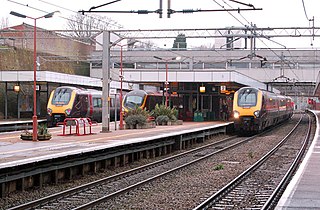
Coventry railway station is the main railway station serving the city of Coventry, West Midlands, England. The station is on the Birmingham loop of the West Coast Main Line (WCML), and is at the centre of a junction where the lines to Nuneaton, and to Leamington converge. It is located on the southern edge of the city-centre, just outside the inner ring road, about 250 yards to the south of junction 6.

The Coventry to Nuneaton Line is a railway line linking Coventry and Nuneaton in the West Midlands of England. The line has a passenger service. It is also used by through freight trains, and freight trains serving facilities on the route.
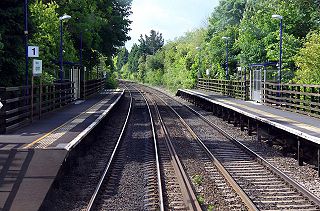
The Cherwell Valley line is the railway line between Didcot and Banbury via Oxford. It links the Great Western Main Line and the south to the Chiltern Main Line and the Midlands. The line follows the River Cherwell for much of its route between Banbury and Oxford.

Canley is a suburban neighbourhood located in southwest Coventry, England. Canley became part of Coventry as a result of successive encroachment of the latter's boundaries between 1928 and 1932, having historically been part of the Stoneleigh parish. Electorally, it is split largely between the Wainbody and Earlsdon wards.

Tile Hill railway station is situated in the west of Tile Hill, Coventry, in the West Midlands of England. The station, and all trains serving it, are operated by West Midlands Railway.

Canley railway station is situated in Canley, Coventry, in the West Midlands of England. The station, and all trains serving it, are operated by West Midlands Railway.
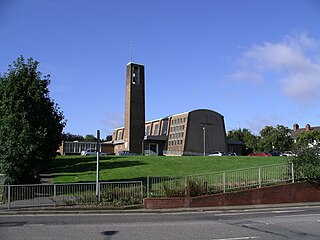
Radford is a suburb and electoral ward of Coventry, located approximately 1.5 miles north of Coventry city centre. It is covered by the Coventry North West constituency.
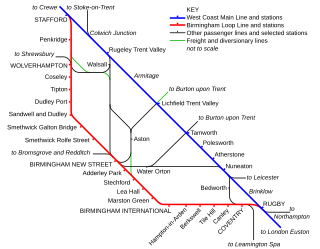
The Rugby–Birmingham–Stafford line is a railway line in the West Midlands of England. It is a loop off the West Coast Main Line (WCML) between Rugby and Stafford via the West Midlands cities of Coventry, Birmingham and Wolverhampton. The direct route between Rugby and Stafford is the Trent Valley Line.
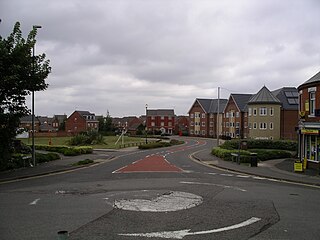
Daimler Green is an urban village approximately two miles north of Coventry city centre, in the West Midlands, England.
Coundon Road railway station was a railway station in Coventry, England, built by the London and North Western Railway in 1850 when it was known as Counden Road railway station

The Coventry to Leamington Line is a railway line linking the city of Coventry with the town of Leamington Spa. The line was opened in 1844 by the London and Birmingham Railway, as far as Milverton. The line was extended to Leamington Spa Avenue in 1851. A connecting line to Berkswell opened in 1884.

A train station, railway station, railroad station or depot is a railway facility or area where trains regularly stop to load or unload passengers or freight or both. It generally consists of at least one track-side platform and a station building (depot) providing such ancillary services as ticket sales, waiting rooms and baggage/freight service. If a station is on a single-track line, it often has a passing loop to facilitate traffic movements.
The Alcester–Bearley branch line was a 6 3⁄4-mile single-track branch railway line in Warwickshire, England. It was built by the Alcester Railway Company. It connected the manufacturing town of Alcester into the Great Western Railway network, opening in 1876.
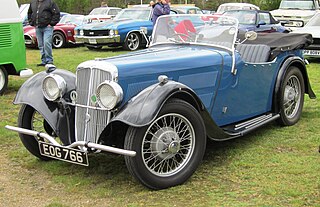
BSA cars were manufactured between 1907 and 1912 in Birmingham then until 1939 in Coventry as well as Birmingham, England. BSA had established a motor-car department in an unsuccessful effort to make use of the Sparkbrook Birmingham factory. An independent part of the same site was occupied by The Lanchester Motor Company Limited. Sales were handled by BSA Cycles Limited. After 1912, manufacture was carried out by group subsidiary Daimler in Coventry or BSA Cycles in Birmingham.

The Great Horseless Carriage Company Limited was formed in May 1896 with a capital of £750,000 in shares of £10 each "of which £250,0000 was for working capital". The company was formed to carry on the horseless carriage industry in England and works with railway and canal adjoining were secured at Coventry. The rights that were purchased had little lasting value and after a number of financial reconstructions beginning in 1898 all activities were terminated by 1910.

Coventry Corporation Transport was the operator of trams and motorbuses in Coventry, Warwickshire from 1912 to 1974. The operations of Coventry Corporation Transport passed to West Midlands Passenger Transport Executive in the local government reorganisation of 1974.
References
- ↑ Private and Untimetabled Railway Stations by G.Croughton
| This article about a West Midlands building or structure is a stub. You can help Wikipedia by expanding it. |
| This article on a railway station in the West Midlands region is a stub. You can help Wikipedia by expanding it. |